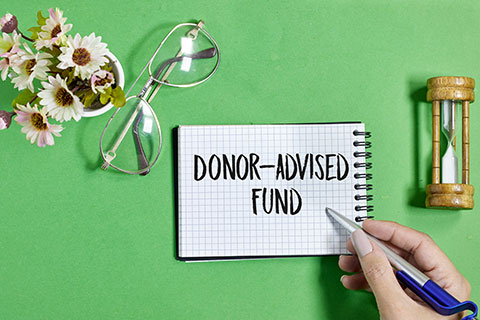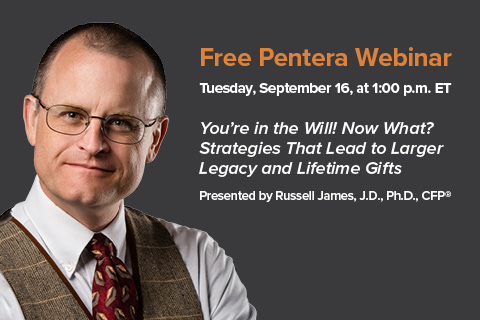The Pentera Blog
Should You Market to Younger or Older or Both?
You've heard about one groundbreaking study that says to market bequests to those aged 40-60. Then another groundbreaking study comes out more recently saying that most of those who make charitable estate gifts add them in their 70s and 80s, within five years of death. And you're left scratching your head.… Which strategy is best? Yes, it is confusing! But the solution is simple: It turns out that both studies are right and you should follow exactly what Pentera has been advising clients to do for years.
Ground-Breaking Study from 2007: Market Younger to the "Community Core" cohort
The Lilly Family School of Philanthropy conducted a study in 2007 that was specifically designed to find out new information about the characteristics and motivations of actual and potential donors to charity. More than 2,000 households in four states were surveyed, and those results were then combined with a survey of more than 1,000 high-net-worth households.
What the study found:
- One-third of all those surveyed said that they currently did not include a charity in their wills but that they would be willing to consider adding one—a huge pool of prospective donors. The study named the most likely group the "Community Core":
- individuals between 40 and 60 years of age
- who were employed and
- had a household income between $50,000 and $75,000
- Thirty-two percent of those in their 40s and 34 percent of those in their 50s said they would consider adding a charity to their estate plans, with the percentages declining as people aged:
- 16 percent of those in their 60s
- 10 percent of those in their 70s
- just 6 percent of those over 80
- "To increase the number of wills that include charities, the nonprofit sector must cultivate younger donors," the study concluded. "Efforts now to engage those people as bequest donors will likely be the most effective way of increasing the number of bequests made to charity in the next 30 years."
The "Oldest Old" Donors
In 2013, Texas Tech Professor Russell James published American Charitable Bequest Demographics¸ an analysis of a massive ongoing study sponsored by the National Institute on Aging that has been looking at 26,000 older Americans for more than 20 years. James focused on just a few questions in the lengthy survey that is administered every two years.
One of the unique components of the survey is that when participants die, post-mortem information is collected from relatives and caretakers. So the survey of those 55 and older includes not just what people say they are going to do in terms of estate planning, but what they actually do. And that led to some of the most fascinating results.
James found that two-thirds of those who actually left charitable estate gifts had added those gifts within the last five years of their lives, in their late 70s or 80s. "Planning within the final five years prior to death is particularly critical," the study concluded.
That seems in direct conflict with the earlier study, which concluded, "While people are most likely to make their final will in their 80s, the decision to include a charity at all appears to be made much earlier."
So what gives?
How It All Reconciles
Since the 2007 study, and well prior to James's research, Pentera clients have been advised under the direction of Pentera President & CEO Claudine A. Donikian to market to the Community Core (as long as their organization meets certain criteria) while also continuing to market to what Ms. Donikian has termed "old friends." Those include donors who are 70 and older and those who have been loyal givers and volunteers, including those who have stopped giving or volunteering in the past few years. Some of James's other findings strongly support that strategy—and go a long way toward reconciling the seemingly contradictory results in the two studies.
Ms. Donikian explains that marketing strategies and choosing your list cannot be approached in a "one-size-fits-all" fashion. Each organization needs to do its due diligence in figuring out whether to shift budget away from the traditional planned giving donor toward a younger audience. For some organizations it's a very wise move when done correctly and thoughtfully. But for others it's a huge mistake.
James found that 36 percent of those who actually left estate gifts responded consistently in the surveys that they weren't going to—answering no every time to the question, "Have you made provisions for any charities in your will or trust?" Some of them said no to that question 10 times over a 20-year period—and then left a charitable gift! And another 30 percent answered the question with a no at least once in the five years before death.
So what happened? They changed their minds—most of them during the two years (or less) between their last survey and their deaths. That makes what people said in the two studies to be in concert: Older people who do not have a charitable beneficiary are more likely to say they are not going to add one. Younger people are more likely to say they are open to adding a charitable beneficiary.
Then when older people get close to death, many of them do add a charitable beneficiary. The reason why is left to speculation. Plausible explanations include that they become more open to making a gift once they face mortality more imminently, that they have a better sense of what will be left in the estate after death, and/or that they might be approached by a gift officer during this important time. The bottom line is that it is most likely a confluence of factors, but the charity must be on their radar screens via marketing and visits to increase the likelihood that it will be chosen. But that is not a likely scenario when a charity is putting its budget toward marketing to a younger cohort (one that has another 30 to 50 years for gifts to mature, based on life expectancies).
So how do these elderly donors choose which charity to benefit? That wasn't included in James's research, either, but here's a likely explanation.
Prior Support ("Loyalty")
Another of James's findings was that as people age, they tend to stop annual giving to charity, even if they had been giving regularly for years. Only about half of all charitable estate donors said they gave to charity in the year of the last survey prior to death—but more than 70 percent of them were giving at least $500/year a decade earlier (and thus were likely to be well-known to their chosen charities). They also tend to stop volunteering. James speculates that health, cognition, and medical expenses may be reasons to stop giving and volunteering.
While there has not been a study on how this final charitable decision is made, those near death who decide to add a charitable beneficiary are almost certainly going to select a charity with which they are already familiar—where they have already donated or been a volunteer. And it's highly unlikely that such a high percentage of folks are experiencing "death-bed conversions" to planned giving. More likely is that they had always hoped to leave part of their estate to charity but weren't willing to commit in writing (or say so in a survey) until they were sure they could afford it. These prospective planned givers have for years likely been prime candidates for residual and contingent bequests, which protect them from making promises they aren't sure they can keep.
The Bottom Line
These two studies, along with other academic research, support components of the planned giving marketing strategy that Ms. Donikian and Pentera have been presenting to clients and at conferences for years:
- Solicit potential donors as young as 40 who are likely creating their first estate plans. A significant percentage are open to a charitable component.
- Ask for planned gifts from your current annual donors and volunteers, who are significantly more likely to have a charitable beneficiary in an estate plan.
- Stay in contact with those who have donated or volunteered but stopped as they have aged; they are very likely to add a charitable beneficiary in their final will if they don't already have one. And ask if they would like to talk about a residual or contingent bequest.


